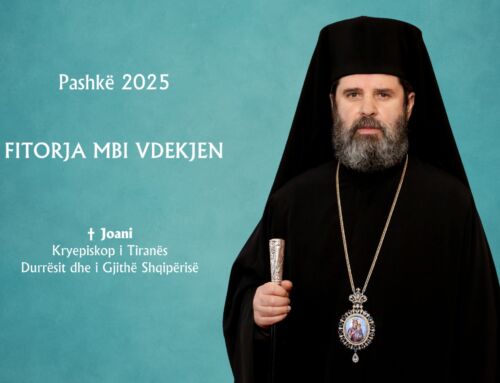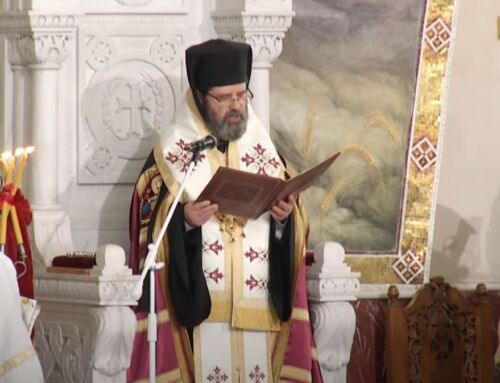The New Monastery of St. Vlash, Durres
11-12 March 2016
Meeting of the Clergy–Laity Assembly of the Orthodox Autocephalous Church of Albania
Two new Metropolis are established: The Metropoli of Apolonia and Fieri and the Metropoli of Elbasan
On 11 and 12 March 2016, at the premises of the Monastery of New St. Vlash, the Clergy-Laity Assembly of the Orthodox Autocephalous Church of Albania was held under the headship of His Beatitude Anastasios, Archbishop of Tirana, Durres and all Albania. Given the fact that a Church Assembly is, above all, a spiritual activity of prayer, its motto was based on the Gospel: “Let us run with endurance … looking unto Jesus, who is the author and finisher of our faith “(Heb. 12: 1-2).
The Assembly proceedings were attended by more than 280 members from the Archdiocese and the three Metropolises (all the clergy and 30 laymen from the archiepiscopate and each metropolis; 10 men, 10 women and 10 young people) as well as associates, who discussed together in the membership meeting and also in working groups issues concerning the life of the Church.
The meeting of the Assembly is provided in the Statute of the Church and is based on Article 70 of the Statute, which states: “This statute supersedes and replaces the previous ones. It may be modified by mutual decision of the Holy Synod, the Church Council of Clergy and Laity and Clergy-Laity Assembly, by absolute majority of their members. Articles 1 to 7 of the Statute cannot be changed or abolished.
This statute was unanimously accepted by the Clergy-Laity Assembly of the Orthodox Autocephalous Church of Albania, which was called for this purpose, on November 4, 2006 and was approved by the Holy Synod, on November 6, 2006. “It has already been 10 years since the approval of the new statute and the time and expansion of our Church activities required necessary changes and improvements.
The Assembly started its work in the afternoon of March 11, 2016 with the Vespers at the church of the Monastery, where the members had a reflection delivered by Bishop of Kruja, His Eminence Andon. Then the first session followed, which was launched by His Beatitude Anastasios, Archbishop of Tirana, Durres and all Albania, who spoke about the major theme of the meeting which was The Completion and Improvement of Some Articles of the Statute of the Orthodox Autocephalous Church of Albania. His Beatitude emphasized their importance for the progress of the Orthodox Autocephalous Church of Albania and highlighted the developments that come as a result of preparations for the Holy and Great Synod in June, in Crete.
One of the most important innovations of such changes, which is related to the development of Church and the administrative needs arising from the increasing number of believers, is the creation of two new Metropolises.
Thus, in Article 8 of the Statute of the Church, two points which dealt with the creation of the new Metropolises were added as following:
5) The Metropolis of Elbasan, which oversees local parishes of Elbasan, Shpati and Librazhd.
6) The Metropolis of Apollonia and Fier, which oversees local parishes of Fier, Patos and Libofshë.
A very important part of the change had to do with the holy monasteries, as reflected in Article 37:
In paragraph 4 of this article it is stated that: For the protection, surveillance and safety of the property of sacred monasteries which flourished in earlier times and lack monks at present, the Economic Commission of the Archdiocese or of any Metropolis is responsible.
Also very important decisions had to be taken regarding the dependence of the holy monasteries. Thus, in paragraph 5 of Article 37 it is stated that: The Holy Monastery of Nativity of Theotokos in Ardenicë, the Annunciation of Virgin Mary in the Island of Zvërnec, the Monastery of St. Marena in Llëngë, and the Monastery of St. Theodors in Dhërmi are considered as Synodical Monasteries.
The 6th point of the article defines the monasteries which serve also as places of pilgrimage for our Church. They are: The Holy Monastery of St. Cosmas of Aitolia in Kolkondas and of St. John the Vladimir in Shijon.
Also further improvements were made in the articles dealing with economic issues with the intention to create space for the creation of limited liability companies by the Holy Synod, such as the hydropower companies (Article 53).
Next, in Article 55, a paragraph was added according to which: 2. No clergyman of any grade, and no member of parish councils, regardless of the function that he maintains, has the right to donate or dispose any movable or immovable assets of the Church. In case of objects for sale, the approval of the Clergy-Laity Council as well as the decision of the Holy Synod are strongly required.
Several improvements were also made to Article 61, on economic matters:
1.The Synodical Commission of Economic and Technical Affairs functions together with the Holy Synod. It consists of: a) the Metropolitan as the chairman b) a bishop c) the General Director of Economic and Technical Office d) a lawyer e) an engineer. All members are appointed by the Holy Synod for a term of five years with the right of renewal. Part of the Synodical Economic and Technical Office are the following branches of: a) Economic Affairs b) Property c) Legal Affairs d) the Technical Office which includes also the Office of Cultural Heritage.
2. The Control Commission which operates along with the Holy Synod is composed of: a) the Archbishop or his designee substitute b) a metropolitan or bishop c) a representative of the Clergy-Laity Council d) an economist e) a lawyer. All members are appointed by the Holy Synod for a five year term with the right of renewal. The work of this commission is conducted by a special secretary who is elected by it.
3. The Economic Commission of the Archdiocese or the Metropolis consists of: a) the relevant Arch- shepherd b) a clergyman who is also a member of the Clergy-Laity Council c) a lay member of the Clergy-Laity Council and two other members (preferably an economist and a lawyer). These members are elected by the Archdiocesan or Metropolitan Council for a term of three years, with the right of renewal.
4. The Archdiocese and the Metropolises manage their finances, have their own Office of Finances and their respective TIN. To meet their financial needs, they send a request to the Chairman of the Holy Synod.
Also, some improvements were made to Article 62, for the administration of the incomes, to Article 63, for the judgment of offenses by clerics and to Article 68, for the signatures and seals.
All these changes were subject to discussion by all members of the Assembly, who also made their proposals for further improvements. They were voted article by article and received the unanimous approval of the participants. Later, the changes approved by the Clergy- Laity Assembly will be further reviewed and approved by the Holy Synod of the Church, according to the Statute of the Orthodox Autocephalous Church of Albania.
The next day, on March 12, 2016, participants were gathered to celebrate the Divine Liturgy, which was attended by Archbishop Anastasios and all members of the Holy Synod, the clergy and laymen. During the liturgy, a reflection was delivered by His Grace Asti, Bishop of Bylis.
Then the next session of the Assembly proceeded during which the participants were informed about the Pan-Orthodox Synod meeting in June, in Crete and the participation of our Church in it. Metropolitan of Korca, His Grace Joan spoke on the subject and highlighted the active and essential role of Archbishop Anastasios in the effort to find consensus during preparatory meetings. Then all participants of the Assembly made a common photo together and continued with group meetings in which they discussed about various topics and issues.
There was also a protest from the Clergy and Laity Assembly towards state authorities, media and public in order to pay attention to the acts of desecration of the Orthodox holy sites and items and to demand their return as quickly as possible according to the Church-State agreement.







